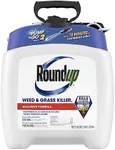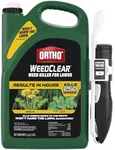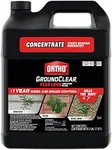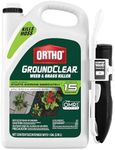Buying Guide for the Best Weed Killer Sprays
Choosing the right weed killer spray can make a significant difference in maintaining a healthy and attractive garden or lawn. The key to selecting the best product is understanding your specific needs and the characteristics of the weed killer sprays available. Here are some important specifications to consider when making your choice.Type of Weed KillerWeed killers can be classified into two main types: selective and non-selective. Selective weed killers target specific types of weeds without harming other plants, making them ideal for lawns and gardens where you want to preserve certain plants. Non-selective weed killers, on the other hand, kill all vegetation they come into contact with, which is useful for clearing areas like driveways or walkways. Choose a selective weed killer if you need to protect other plants, and a non-selective one for total vegetation control.
Systemic vs. ContactSystemic weed killers are absorbed by the plant and travel through its system to kill it from the inside out, which is effective for perennial weeds with deep roots. Contact weed killers, however, only affect the parts of the plant they touch, making them suitable for annual weeds or surface-level control. If you are dealing with deep-rooted, persistent weeds, a systemic weed killer is the better choice. For quick results on surface weeds, a contact weed killer will suffice.
Pre-emergent vs. Post-emergentPre-emergent weed killers prevent weed seeds from germinating and are best used before weeds appear. Post-emergent weed killers are used to kill existing weeds. If you are planning ahead and want to prevent weeds from growing, opt for a pre-emergent product. If you already have weeds that need to be dealt with, a post-emergent weed killer is necessary.
Active IngredientsThe active ingredients in weed killers determine their effectiveness and safety. Common ingredients include glyphosate, 2,4-D, and dicamba. Glyphosate is a non-selective, systemic herbicide effective against a wide range of weeds. 2,4-D and dicamba are selective herbicides that target broadleaf weeds. Understanding the active ingredients helps you choose a product that is effective against the specific weeds you are dealing with. Always read the label to ensure the product is suitable for your needs.
Application MethodWeed killers come in various forms, including ready-to-use sprays, concentrates, and granules. Ready-to-use sprays are convenient and easy to apply, making them ideal for small areas or spot treatments. Concentrates need to be mixed with water and are more economical for large areas. Granules are spread over the soil and are often used for pre-emergent weed control. Choose the application method that best fits the size of the area you need to treat and your convenience.
RainfastnessRainfastness refers to how quickly a weed killer becomes resistant to being washed away by rain. This is important if you live in an area with frequent rainfall. Products with a shorter rainfast period can be more effective in such climates. Check the label for information on how long the product needs to dry before it becomes rainfast, and choose one that fits your local weather conditions.
Environmental ImpactConsider the environmental impact of the weed killer you choose. Some products are more eco-friendly and biodegradable, posing less risk to wildlife, pets, and beneficial insects. If environmental safety is a priority for you, look for products labeled as organic or those with natural ingredients. Always follow the application instructions to minimize any negative impact on the environment.






















